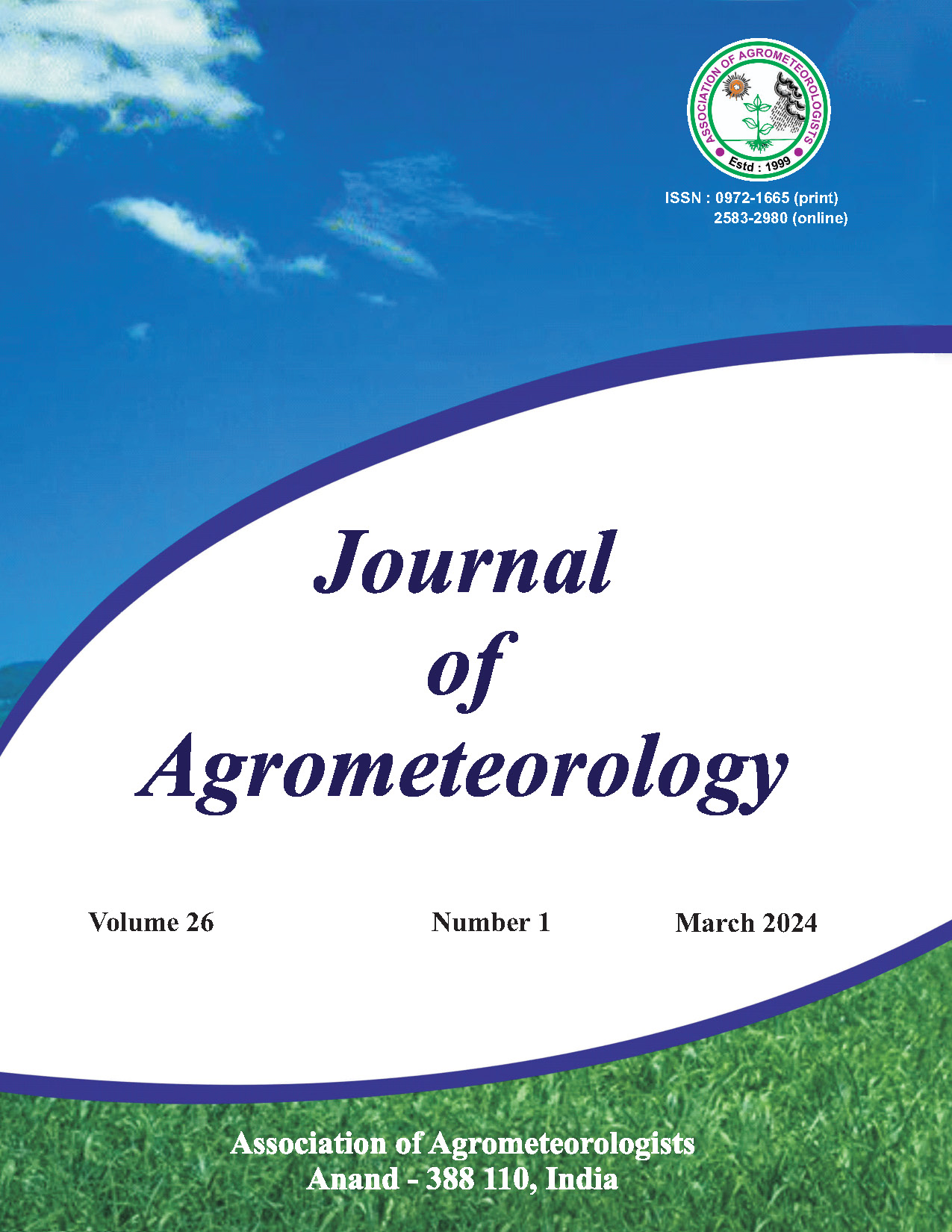Potential yield of world maize under global warming based on ARIMA-TR model
DOI:
https://doi.org/10.54386/jam.v26i1.2483Keywords:
World maize, Potential yield, Global warming, ARIMA-TR model, Top yieldAbstract
With continuous increase of population and demand for nutritional food, analyzing potential yield of world maize affected by global warming is of great significance to direct the crop production in the future. Thus, in this paper both average and top (national) yields of world maize between 2021 and 2030 are projected creatively using ARIMA-TR (Auto-regressive Integrated Moving Average and Trend Regression) model based on historic yields since 1961. The impact of global warming on the yields of world maize from 1961 to 2020 was analyzed using unary regression model. Our study concludes that between 2021 and 2030, average yield of world maize is projected to be from 5989 kg ha-1 to 6703 kg ha-1 while the top yield from 36530 kg ha-1 to 44271 kg ha-1, or the average ranging from 16.39% decreasingly to 15.14% of the top; from 1961 to 2020 global warming exerts positive effect on average yield of world maize less than on the top, which partly drives the gap between these two yields widened gradually; for world maize by 2030, the opportunities for improving global production should be mainly dependent on the advantage of high-yield countries.
References
Amiri E, Irmak S, and Yaghouti H, (2022). Performance of WOFOST Model for Simulating Maize Growth, Leaf Area Index, Biomass, Grain Yield, Yield Gap, and Soil Water under Irrigation and Rain-fed Conditions. J. Irrig. Drain. Engg., 148(2). https://doi.org/10.1061/(ASCE)IR.1943-4774.0001644
Cai Cheng-Zhi, Liao Cong-Jian, Xiao Dan, Zeng Xiao-Shan, and Zuo Jin. (2021). Global warming and world soybean yields. J. Agrometeorol., 23(4): 367–374. https://doi.org/10.54386/jam.v23i4.139
Cai Cheng-Zhi, Cao Wen-Fang, Zeng Xiao-Shan, Zuo Jin, Xiao Dan, Liao Congjian, and Kanwalwaqar. (2020). Yield potential of world wheat based on ARIMA model under global warming. J. Agrometeorol., 22(4): 397–406. https://doi.org/10.54386/jam.v22i4.442
Duarte YCN, and Sentelhas PC, (2019). Intercomparison and Performance of Maize Crop Models and Their Ensemble for Yield Simulations in Brazil. Intern. J. Plant Prod., 14(1): 127-139.
Jensen L, (1990). Guidelines for the application of ARIMA models in time series. Res. Nursing Health, 13(6): 429-435.
Liu D, Mishra AK, and Yu ZB, (2019). Evaluation of hydroclimatic variables for maize yield estimation using crop model and remotely sensed data assimilation. Stoch. Environ. Res. Risk Assess., 33(7): 1283-1295.
Martinez MM, Nakaegawa T, Pinzon R, Kusunoki S, Gordon R, and Sanchez-Galan JE, (2020). Using a Statistical Crop Model to Predict Maize Yield by the End-Of-Century for the Azuero Region in Panama. Atmosph., 11(10): 1097-1116.
Mohanty M, Sinha NK, Patidar RK, Somasundaram J, Chaudhary RS, Hati KM, Reddy KS, Prabhakar M, Cherukumalli SR, and Patra AK, (2017). Assessment of maize (Zea mays L.) productivity and yield gap analysis using simulation modelling in subtropical climate of central India. J. Agrometeorol., 19(4): 342-345. https://doi.org/10.54386/jam.v19i4.603
Pourhadian H, Kamkar B, Soltani A, Mokhtarpour H, (2019). Evaluation of forage maize yield gap using an integrated crop simulation model-satellite imagery method (Case study: four watershed basins in Golestan Province). Arch. Agron. Soil Sci., 65(2): 253-268.
Pushpa, Chetna, Aditi, and Urmil Verma. (2022). ARIMA and ARIMAX models for sugarcane yield forecasting in Northern Agro-climatic zone of Haryana. J. Agrometeorol., 24(2): 200–202. https://doi.org/10.54386/jam.v24i2.1086
Rahimi-Moghaddam S, Kambouzia J, Deihimfard R, (2018). Adaptation strategies to lessen negative impact of climate change on grain maize under hot climatic conditions: A model-based assessment. Agric. Forest Meteorol., 253: 1-14.
Zhu BX, Chen SB, Cao YJ, Xu ZY, Yu Y, Han C, (2021). A Regional Maize Yield Hierarchical Linear Model Combining Landsat 8 Vegetative Indices and Meteorological Data: Case Study in Jilin Province. Remote Sens., 13(3): 356-370.
Downloads
Published
How to Cite
License
Copyright (c) 2024 CHENGZHI CAI, TINGTING DENG, WENFANG CAO

This work is licensed under a Creative Commons Attribution-NonCommercial-ShareAlike 4.0 International License.
This is a human-readable summary of (and not a substitute for) the license. Disclaimer.
You are free to:
Share — copy and redistribute the material in any medium or format
Adapt — remix, transform, and build upon the material
The licensor cannot revoke these freedoms as long as you follow the license terms.
Under the following terms:
Attribution — You must give appropriate credit, provide a link to the license, and indicate if changes were made. You may do so in any reasonable manner, but not in any way that suggests the licensor endorses you or your use.
NonCommercial — You may not use the material for commercial purposes.
ShareAlike — If you remix, transform, or build upon the material, you must distribute your contributions under the same license as the original.
No additional restrictions — You may not apply legal terms or technological measures that legally restrict others from doing anything the license permits.
Notices:
You do not have to comply with the license for elements of the material in the public domain or where your use is permitted by an applicable exception or limitation.
No warranties are given. The license may not give you all of the permissions necessary for your intended use. For example, other rights such as publicity, privacy, or moral rights may limit how you use the material.





